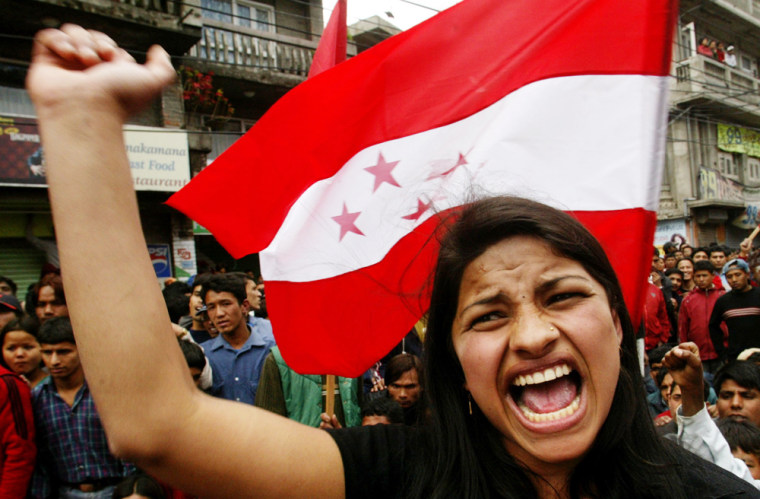Security forces fired on thousands of pro-democracy protesters in southeastern Nepal on Wednesday, killing at least four, and the government reimposed a curfew in the capital to prevent a massive rally urging the king to loosen his grip on power.
Two weeks of bloody opposition protests and a general strike against the rule of King Gyanendra have paralyzed Nepal, leaving the country at its most volatile since the monarch seized power 14 months ago. At least 10 people have been killed during the demonstrations.
Officials claimed security forces in Chandragadi, about 310 miles southeast of Katmandu, opened fire after being shot at by protesters, who also hurled bricks and debris. The government has made similar claims during the past two weeks, but those accounts have not been confirmed independently.
The region’s chief administrator, Bhola Siwakoti, also said the protesters defied a ban in the town and were sacking government and private property.
The were conflicting reports of how many were killed. The Defense Ministry said two people were dead, but another Nepali official said four were killed and a U.N. official said five were killed. Both officials spoke on the condition of anonymity because the sensitivity of the situation.
At least 10 killed by security forces
The latest deaths bring to at least 10 the number of people killed by security forces during the protests. Since the opposition campaign began April 6, ordinary Nepalis have joined rallies alongside students and political activists.
The royal government has responded harshly, claiming that Nepal’s communist insurgents — who are allied with the political opposition — had violently infiltrated the rallies. Police have beaten, tear gassed and arrested thousands of protesters.
“Democratic rights do not exist,” said Ian Martin, Nepal-based representative of the U.N. High Commissioner for Human Rights. “The opportunities for peaceful protests have been closed down.”
So far, he said, close to 4,000 people have been arrested, and about 700 are still detained.
The king dismissed an interim government and seized power in February 2005, claiming a need to restore order and crush a communist insurgency that has killed nearly 13,000 people over the past decade.
Many of Nepal’s 27 million people initially welcomed the king’s power grab because they were fed up with the corrupt and squabbling political elite. But the worsening communist insurgency and a faltering economy have fueled discontent.
Hours before Wednesday’s shootings, the royal government freed two top opposition leaders — Madhav Kumar Nepal of the Communist Party of Nepal and Ram Chandra Poudel of the Nepali Congress — who had been jailed for three months.
No reasons were given for their release, and both pledged to join the protests.
“We will launch the protest (against the king) in an effective way until full sovereignty is returned to the people,” Kumar Nepal told reporters.
Many here saw the releases as an attempt by Gyanendra to show flexibility on the day an Indian special envoy arrived to press him to compromise with the opposition.
“I am always optimistic,” said envoy Karan Singh, who began talks with the opposition Wednesday and was to meet Gyanendra on Thursday.
Curfew imposed in Katmandu
Later Wednesday, the government imposed an 18-hour curfew in Katmandu and surrounding areas — an attempt to scuttle opposition plans to bring 100,000 people Thursday onto the ring road skirting the capital. Such a rally would dwarf all earlier ones.
The government said the curfew would run from 2 a.m. to 8 p.m. Thursday in Katmandu, the suburb of Lalitpur and in areas 650 feet beyond both.
On Wednesday morning, the government imposed a daylong curfew in the resort town of Pokhara, the scene of daily protests the past two weeks. Security forces were ordered to shoot violators on sight.
Despite the curfew, some 250 professors took to the streets of Pokhara and were arrested.
There also were protests of a few thousand people each in Katmandu.
The United States, meanwhile, again urged Gyanendra to restore democracy, with White House press secretary Scott McClellan saying in Washington that the unrest in the country “will only worsen.”
“Arrests and violence accompanying the pro-democracy demonstrations only add to the insecurity and compound the serious problem facing Nepal,” he told reporters.
The royal government summoned U.S. Ambassador James Moriarty on Tuesday to protest the envoy’s remarks that the king could end up fleeing the Himalayan nation if he did not compromise with the opposition.
Aside from the protests, the strike has closed shops and forced vehicles off the streets and highways for 14 straight days, causing shortages of food and other necessities in Katmandu.
